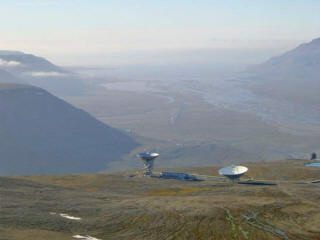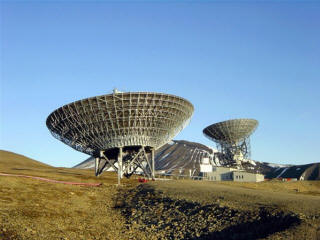|

by Henrik Palmgren
January 21, 2010
from
RediceCreations Website

Have you ever heard
of EISCAT (European Incoherent Scatter facility)?
EISCAT, short for the European Incoherent Scatter facility, is
located at Ramfjord, about 20 Kilometers South of Tromsø in Norway
where the "Norway Spiral" or the Blue Spiral was seen back in
December 2009.
It's been said that the "spiral test" or "experiment"
caused all kinds of side effects.
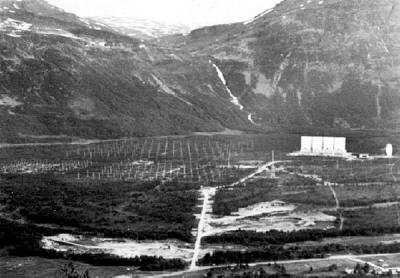
At the
EISCAT in Tromsø they also have
an Ionospheric Heater facility with a Frequency Coverage of 4 to 8
MHz. In contrast,
HAARP in Gakona, Alaska has a Frequency Coverage
of 2.8 - 10 MHz.
You could say that EISCAT is the HAARP of
Scandinavia.
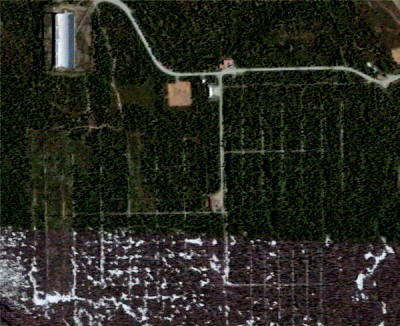
Image from above in
Google Maps
The following is from the
EISCAT
website:
The Heater is used for ionospheric
modification experiments applying high-power transmissions of
high-frequency electro-magnetic waves to study plasma parameters
in the ionosphere.
The name Heating stems from the fact that
these high power electromagnetic waves, which are transmitted
into the ionosphere with high-gain antennas, heat the electrons
and thus modify the plasma state. To create plasma turbulence,
the transmitted frequencies have to be close to the plasma
resonances, which are 4 to 8 MHz.
The big question is obviously if this
facility’s ability to heat the ionosphere and create
plasma
turbulence was responsible for creating the "Norway Spiral"?
I’d say yes!
Look at the following video:
We don't know yet.
These questions remain but I think we can throw
out the "Failed Russian Rocket theory" with certainty now at least.
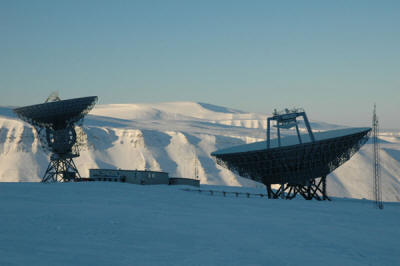
EISCAT Svalbard Radar
in Longyearbyen.
Remember that very
close to this facility there is the "Doomsday Seed Vault" in
Svalbard
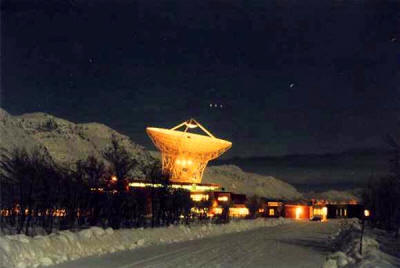
In Tromsø they also have a 931 MHz Ultra High Frequency Radar.
Here is some more information from
EISCAT's website:
What is EISCAT?
A brief description of the system
The EISCAT Scientific Association is an international research
organization operating three incoherent scatter radar systems,
at 931 MHz, 224 MHz and 500 MHz, in Northern Scandinavia. It is
funded and operated by the research councils of Norway, Sweden,
Finland, Japan, China, the United Kingdom and Germany
(collectively, the EISCAT Associates.)
EISCAT (European Incoherent Scatter) studies the interaction
between the Sun and the Earth as revealed by disturbances in the
magnetosphere and the ionized parts of the atmosphere (these
interactions also give rise to the spectacular aurora, or
Northern Lights).
The radars are operated in both
Common and Special Program modes, depending on the particular
research objective, and Special Program time is accounted and
distributed between the Associates according to rules which are
published from time to time.
One EISCAT transmitter site consisting of a UHF system and a VHF
system is located close to the city of Tromsø, in Norway, and
additional receiver stations are located in Sodankylä, Finland,
and Kiruna, Sweden.
The EISCAT Headquarters are also located in
Kiruna.
In 1996 the EISCAT Scientific Association constructed a
second incoherent scatter radar facility, the EISCAT Svalbard
Radar (ESR), near Longyearbyen on the island of Spitsbergen, far
to the North of the Norwegian mainland.
The Incoherent Scatter Radar requires sophisticated technology
and EISCAT engineers are constantly involved in upgrading the
systems.
In addition to the incoherent scatter radars, EISCAT also
operates an Ionospheric Heater facility at Ramfjordmoen
(including a Dynasonde) to support various active plasma physics
experiments in the high latitude ionosphere.
EISCAT's ionospheric Heating facility
including Dynasonde
The Heating facility is situated next to the UHF and VHF
incoherent scatter radars. See the list of publications that
have come out of this facility since its construction in 1979.
The Heater is used for ionospheric modification experiments
applying high-power transmissions of high-frequency
electro-magnetic waves to study plasma parameters in the
ionosphere. The name Heating stems from the fact that these high
power electromagnetic waves, which are transmitted into the
ionosphere with high-gain antennas, heat the electrons and thus
modify the plasma state.
To create plasma turbulence, the
transmitted frequencies have to be close to the plasma
resonances, which are 4 to 8 MHz.
Here are some more photos from the sites
in:
|








